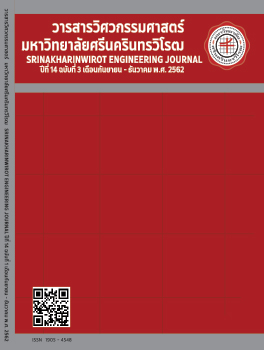Mathematical Modeling of Shiitake Mushroom Drying Using Infrared-Vacuum Technique
Main Article Content
Abstract
The objective of this research is to study the drying of shiitake mushrooms by infrared-vacuum technique. Specific energy consumption, effective diffusion coefficient and suitable mathematical models to predict the drying kinetics of shiitake mushrooms were investigated under the drying conditions with the drying temperature of 50, 60, and 70 oC and the absolute pressure in drying chamber at 10, 15, and 20 kPa. The results showed that, the increment of the temperature or the reduction of absolute pressure in the drying chamber, the drying rate was high and low specific energy consumption. Effective moisture diffusivity ranged from1.77x10-9 to 2.685x10-9 m2/s with increasing values according to higher drying temperature and lower absolute pressure in drying chamber. Midilli mathematical model gave the most appropriate predictions due to the highest coefficient of determination (R2=0.99689), the lowest root mean square error (RMSE=0.18370) and chi square (c2=0.00021).
Article Details
Copyright belongs to Srinakharinwirot University Engineering Journal
References
[2] U. Teeboonma and S. Jongjam, “Ginger drying using infrared-vacuum technique,” Burapha Sci. J., vol. 15, no. 2, pp. 76-86, 2010.
[3] M. Younis, D. Abdelkarim and A.Z. El-Abdein, “Kinetics and mathematical modeling of infrared thin-layer drying of garlic slices,” Saudi Journal of Biological Sciences, vol. 25, no. 2, pp. 332-338, Feb. 2018.
[4] S. Rungsawang, S. Jaekhum, N. Uengkimbuan and K. Witinantakit, “Shiitake Mushroom Drying Using Vacuum and Infrared Radiation Technique,” in 12th Conference On Energy Network of Thailand, Phitsanulok, 2016, pp. 1591-1596.
[5] K. Sathapornprasath and P. Praneetpolkrang, “Modeling pepper drying by jet spouted bed technique using ANFIS system,” SWU Engineering Journal, vol.13, no. 1, pp. 176-186. Jan.-Apr. 2018.
[6] A.O. Omolola, P.F. Kapila and H.M. Silungwe, “Mathematical modeling of drying characteristics of Jew’s mallow (Corchorus olitorius) leaves,” Information Processing in Agriculture, vol. 6, no. 1, pp.109-115, Mar. 2019.
[7] AOAC (Association of Official Analytical Chemists). Official Methods of Analysis. 17thed. Association of Official Analytical Chemists. Maryland: Gaithersburg, 2000.
[8] N. IZLI, G IZLI and O. Taskin, “Influence of different drying techniques on drying parameters of mango,” Food Science and Technology, vol. 37, no. 4, pp. 604-612, Oct.-Dec. 2017.
[9] Q. Lui and F.W. Bakker-Arkema, “Stochastic modeling of grain drying, part 2; model development,” Journal of Agricultural Research, vol. 66, pp. 275-280, Apr. 1997.
[10] G.P. Sharma and S. Prasad, “Drying of garlic cloves by microwave-hot air combination,” Journal of Food Engineering, vol. 50, vol. 99-105, Nov. 2001.
[11] H. Togrul, “Simple modeling of infrared drying of fresh apple slices,” Journal of Food Engineering, vol. 71, pp. 311-323, Dec. 2005.
[12] A. Ruiz-Celma, S. Rojas and F. Lopez-Rodriguez, “Mathematical modeling of thin-layer infrared drying of wet olive husk,” Chemical Engineering and Processing, vol. 47, pp. 1810-1818, Sep. 2008.
[13] M. Ozdemir and Y. Onur-Devres, “The thin layer drying characteristics of hazelnuts during roasting,” Journal of Food Engineering, vol. 42, pp. 225-233, Dec. 1999.
[14] A. Midilli, H. Kucuk and Z. Yapar, “A new model for single-layer drying,” Drying Technology, vol. 20, no. 7, pp. 1503-1513, Jul. 2002.
[15] L.R. Verma, R.A. Bucklin, J.B. Endan, F.T. Wratten, “Drying effects of drying air parameters on rice drying models,” Trans. ASAE, vol. 85, pp. 296-301, Jan. 1985.
[16] I. Alibas, “Microwave, Air and Combined Microwave-Air Drying of Grape Leaves (Vitis vinifera L.) and the Determination of Some Quality Parameters,” International Journal of Food Engineering, vol. 10, no. 1, pp. 69-88, Jan. 2014.
[17] S.J. Babalis, E. Papanicolaou, N. Kyriakis and V.G. Belessiotis, “Evaluation of thin-layer drying models for describing drying kinetics of figs (Ficus carica),” Journal of Food Engineering, vol. 75, pp. 205-214, Jul. 2006.
[18] V. Demir, T. Gunhan, and A.K. Yagcioglu, “Mathematical modelling of convection drying of green table olives,” Biosystems Engineering, vol. 98, no. 1, pp. 47-53, Sep. 2007.
[19] J. Crank, “The mathematics of diffusion,” Clarendon press, Oxford, UK, 1972, pp. 47-53.
[20] S. Devahastin, “Drying of Foods and Biomaterials,” Top Publishing, 2012, pp. 253-260
[21] T. Swasdisevi, S. Devahastin, P. Sa-Adchom and S. Soponronnarit, “Mathematical modeling of combined far-infrared and vacuum drying banana slice,” Journal of Food Engineering, vol. 92, no. 1, pp. 100-106, May. 2009.
[22] I. Alibas and N. Koksal, “Convective, vacuum and microwave drying kinetics of mallow leaves and comparison of color and ascorbic acid values of three drying methods,” Food Science and Technology, vol. 34, no. 2, pp. 358-364, Apr.-June 2014.


